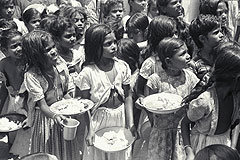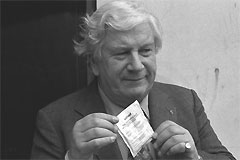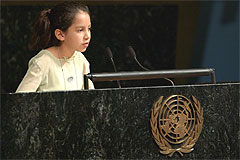About UNICEF
UNICEF at 65: Looking back, thinking ahead
By Eric Mullerbeck and David Anthony
NEW YORK, USA, 9 December 2011 - On 11 December, UNICEF celebrates its 65th anniversary. Created in 1946 from the residual resources from the United Nations Relief and Rehabilitation Administration to secure the fate of Europe’s children, few then imagined that it would still be in existence today. In the six and a half decades since it was formed, UNICEF continues to assist children affected by war and crisis, but has also taken on a much broader and ever-evolving role in international development, working across political, national and social divides to provide integrated services to children and advocate for the full spectrum of their rights.
 |
| © UNICEF/NYHQ1949-0001/Photographer Unknown |
| Circa 1949, a crowd of girls at the Mary Immaculate orphanage, in Tirupattur in the North Arcot district of Madras State, have just received bowls of rice provided by UNICEF. |
In recent years, a renewed emphasis on equity for children has become a cornerstone of the organization’s programme, policy and advocacy work. An examination of history underscores exactly why the time is now right for the world to refocus on equity, not only as a key guiding principle for development, but also as the best way to achieve the most sustainable and effective impact in human development.
Foundation and early work
Back in 1946 the lingering effects of the destruction caused by World War II were still affecting millions of people in Europe. Many were without basic shelter, adequate clothing or food. Especially hard hit were children, fully half of whom were dying before their first birthday in some affected areas. Existing relief mechanisms were being phased out.
In response to many voices of concern, on 11 December 1946 the UN General Assembly unanimously established the UN International Children’s Emergency Fund (UNICEF) to mount urgent relief programmes for children. UNICEF was directed to provide its aid ‘without discrimination because of race, creed, nationality, status or political belief’. In this way, principles grounded in rights and equity helped guide UNICEF’s work from the very beginning.
Children and development
By the 1960s, there was ever-growing global interest in economic and social development as a key enabler for countries to overcome poverty and meet the needs of their own populations. UNICEF, faced with a torrent of ideas and having taken on board its lessons from the previous decade, decided to chart its own path by convening an inter-agency study incorporating ‘state of the art’ analyses from other UN agencies on the needs of children in their respective spheres. Several UN agencies, including the World Health Organization, Food and Agriculture Organization, International Labour Organization, United Nations Educational, Scientific and Cultural Organization, and the UN Bureau of Social Affairs, contributed to the final report, 'Children of the Developing Countries', which represented a watershed in nations’ views on how to support and assist their youngest citizens.
 |
| © UNICEF/NYHQ1986-0158/Horst Cerni |
| In 1986 in Germany, UNICEF Goodwill Ambassador Peter Ustinov holds up a packet of oral rehydration salts, the key component of oral rehydration therapy. |
This report presented an integrated theory of child development and made the case for systematic inclusion of children’s needs in national development plans. It also changed UNICEF’s work, by expanding the scope of the organization’s engagement to include all branches of government, and by expanding its work to address the needs of ‘the whole child’, including broader psychosocial needs as well as those of parents and caregivers.
Child Survival and Development Revolution
In the early 1980s, child mortality rates were seen as an indicator of a country’s level of development. UNICEF and its then Executive Director, Jim Grant, reversed this conventional wisdom in 1982, proposing that a direct attack on child mortality would yield dividends for a country’s economic and social development. This was the beginning of the ‘child survival and development revolution’, in which simple primary health care techniques, developed or refined over preceding decades, would be applied in a concerted effort to vanquish common infections of early childhood.
The techniques were known collectively as GOBI: ‘G’ for growth monitoring, ‘O’ for oral rehydration therapy, ‘B’ for breastfeeding and ‘I’ for immunization. GOBI was appealing because its methods were low in cost, and its appeal was enhanced by the accompanying social mobilization strategy advocated by UNICEF. The strategy enlisted support from all walks of society in the name of child survival: media, religious leaders, celebrities of all stripes, non-governmental organizations as well as UNICEF’s traditional government partners, all played a role.
Child rights take center stage
In 1987, UNICEF threw its weight behind the work on establishing a new convention to replace the 1959 Declaration of the Rights of the Child. Its eventual support and convening capacity were decisive factors leading to the adoption of the Convention on the Rights of the Child in November 1989 by the UN General Assembly. The Convention entered into international law on 2 September 1990.
 |
| © UNICEF/NYHQ2002-0148/Susan Markisz |
| Children's Forum delegate Gabriela Azurduy Arrieta, 13, from Bolivia, addresses the United Nations Special Session on Children in May 2002. |
The legal protections enshrined in the Convention helped propel issues of child protection to the top of the political agenda, and paved the way for major initiatives, supported by UNICEF and many other partners, including the World Congress Against Commercial Sexual Exploitation of Children in 1996, the UN study on the Impact of Armed Conflict on Children in 1996, the adoption by two thirds of the world’s nations of the Convention prohibiting anti-personnel mines in 1997, and the adoption of the global agenda for eliminating the worst forms of child labour in 1997. The Convention and its protocols continue remain the foundation of UNICEF’s mission today.
An equity focused approach
In the first decade of the 21st century UNICEF’s work continued on all aspects of children’s well-being. Child survival remained a core theme; global progress on child survival meant that the number of young children dying each year declined to well below 10 million, from more than 12 million in 1990 – even as the global under-five population continued to increase. UNICEF’s humanitarian work was strengthened by the updating of the Core Commitments for Children in Emergencies. Protection of vulnerable children and combating HIV/AIDS figured more prominently in UNICEF programmes than ever before, as did gender equality and the empowerment of women and girls, work with and for adolescents, and partnership building. Education, nutrition, health and immunization continued to be fundamental components of UNICEF’s programming, all of which has taken a human-rights based approach with a focus on results.
Since 2010 UNICEF has brought to its own work, and emphasized in the global development dialogue, a renewed focus on equity.
Principles of equity were part of UNICEF’s guiding vision from the very day of its creation on 11 December 1946, and form part of its mission statement. In everything UNICEF does, the most vulnerable children and countries in greatest need are to be given the highest priority. Equity is also a cornerstone of the international agreements and compacts developed in recent decades such as the Convention on the Rights of the Child and the Millennium Declaration that define responsibilities and guide the work of all who are concerned with furthering the well-being of children. But it has become increasingly clear that equity is not only the right thing to do, it is also potentially the most cost-effective way of achieving global goals for children.
Like most things worthwhile, adopting equity-focused approaches will be challenging. Throughout its history, however, UNICEF has always helped lead thinking and action in new directions, continually seeking and finding ways to support progress for the world’s children by challenging the prevailing conventional wisdom. The equity approach continues this tradition and holds the promise of helping realize children’s rights everywhere to a degree never before possible.

